
Jetpack Joyride, by Halfbrick is, hands down, one of the best built games for iOS.1 While I could talk about the many things they did right with this title, the thing I want to discuss today is the currency.
The currency concept is simple. In game, you collect coins as you run. At the end of your run you might have a chance to win more coins in the slot machine. If you complete a mission you might win even more coins. Between runs you have the option to buy new clothes, upgrade jetpacks, buy gadgets, or purchase power-ups, all using coins. If you run out of coins or want to get a lot of coins without playing, you can spend real-life dollars to get a pile of coins which you can spend in game.
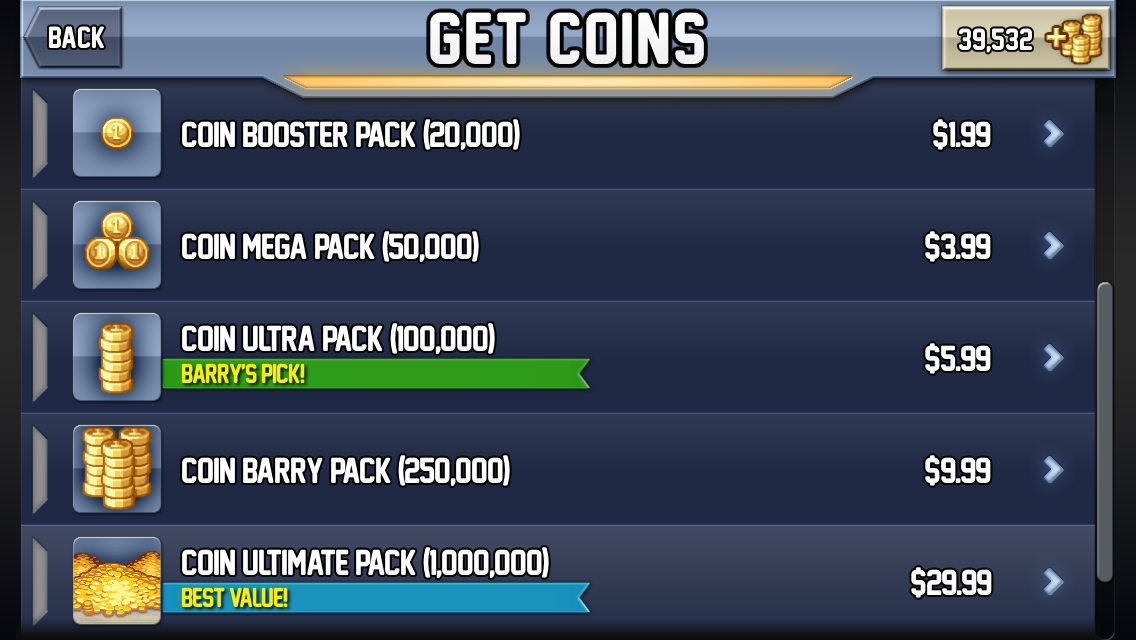
I like this because it makes sense. There’s dollar to coin ratio and you can choose if it’s worth the purchase. If you don’t want to pay, you can play, and save up coins until you can get anything in the game. The system works really well.
(Recently they have added some items to the game that you need to purchase with real-money. It’s not ideal, but I can understand why they are doing it.) I appreciate why they are doing it, but I am more happy that they are only offering a single limited-time deal at one time. In my mind, I see this as a little bonus. The developers are saying, if you really like this game, why not give us $1.99? We’ll throw in something fun if you do, but if not, that’s okay. Keep playing.

I don’t feel pressured by this, I don’t feel guilted into buying it, I don’t even really feel it’s necessary, it’s almost a donate button in a sense. I dig that.

Another good example of this is a game called Dots: A Game About Connecting by Betaworks One.
Dots is all about connecting dots. For every dot you connect, it gets added to your bank. At the end of each round you can buy power-ups using the dots you collected. If you run out of dots and need more you can spend real money to buy dots.
Again, this type of system feels like a donate button. If you like the game and want to support me, here’s a way to send me money. However, the main thing is I want you to enjoy the game.
I can’t speak to the financial feasibility of this type of system, but as a consumer this system works fantastic.
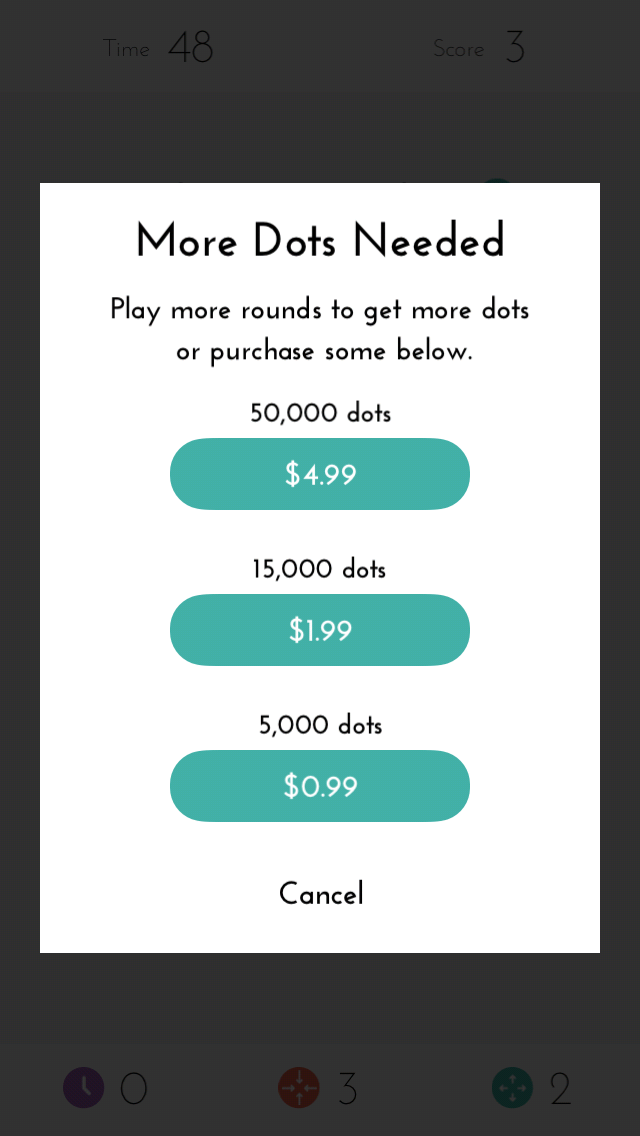

Let’s compare this to another of my favorite games, Extreme Road Trip 2 by Roofdog Games.2
In Extreme Roadtrip 2 the concept is fairly similar: as you drive you collect coins. You can use the coins to buy new cars. Except, some of the cars cost Dollars rather than coins. Dollars come from two places, the first is by breaking open crates. There are three ways to get crates. The first is to complete five missions, which are given to you three at a time. The second is to go up a level, which you do by playing and driving further. The final way to get crates is to watch ads. I don’t know what the limits are for ads, but if you watch an ad you’ll get a crate. Sometimes you can watch several ads in a row, other times you are told there are no ads to watch.
Now, breaking open a crate does not guarantee you get dollars, though. There are three power-ups in the game that can be won in crates and sometimes you win coins too.
The second way to make dollars is a new feature added to the game called a “Frenzy Run” which you are allowed to do once a day. In this mode you drive a monster truck through an arena filled with coins, boxes, and hot air balloons, the latter two have a small chance to contain dollars.
But there’s a third currency that has been added to the game. Prestige tokens! If you beat all 61 missions with a car, the missions get reset and you get a token! If you do it again, you’re given another token, but you are only allowed two tokens per car. There is a special set of 6 cars which can only be bought with tokens, the most expensive of which costs 90 tokens.
The game has a store where you can buy coins and dollars for real-money, the prestige tokens are only available if you complete the missions. When compared to prices in Jetpack Joyride though, the prices are magnitudes more expensive. As I went from one game to the next I was a bit shocked at the prices, these are, after all, digital goods.
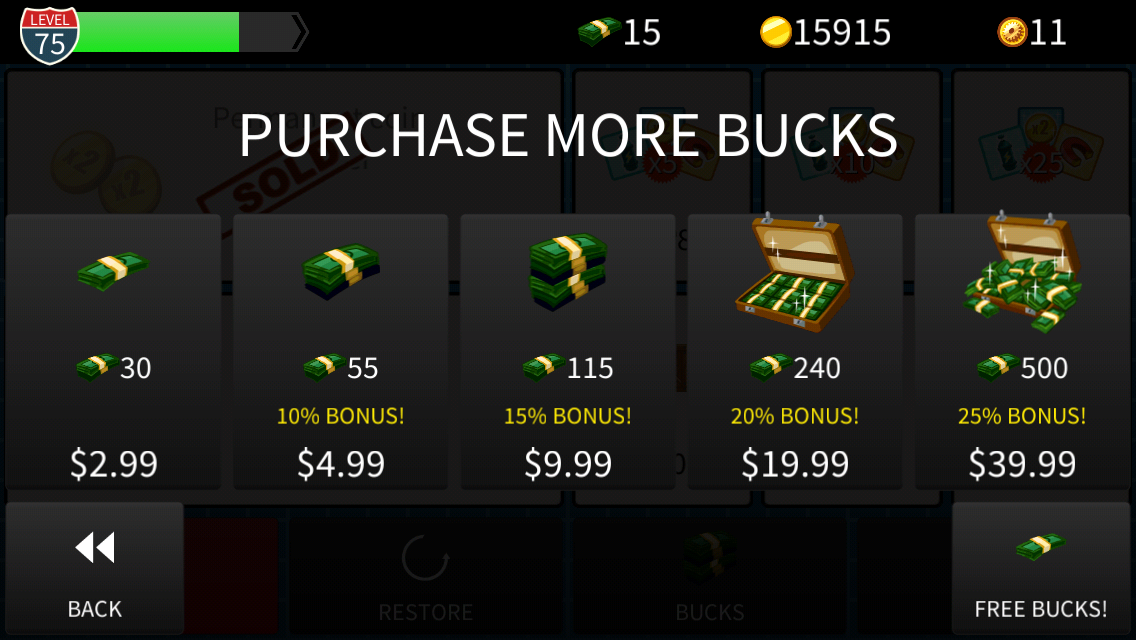
Now, perhaps roofdog games priced the goods to encourage it’s players to play, not to purchase their way through the game, but I’m skeptical. From it’s initial release the game added a plethora of new cars all of which were priced heavily in terms of both gameplay and money. The addition of the “Frenzy Run” was a slight admission that the cars were priced too high.
In one of the latest updates the game now displays ads between some menus, which too me is a sign that the developer wants to get paid more, and he offers an “ad-free” upgrade fro $2.99.
While the game is fun and I still enjoy it, I can’t help but feel that where Jetpack Joyride is a fun Uncle sitting on the couch just wanting me to enjoy a good game, Extreme Roadtrip 2 is a stern faced clerk eyeing me suspiciously and not so subtly gesturing towards the cash register while I page through a book on from the shelf.
There are certainly good reasons to have two currencies in the sense that one is easier to find than the other. My confusion is that there’s no conversion rate between them. Maybe there shouldn’t be, but since both currencies “do the same thing” I don’t see any reason there couldn’t be.
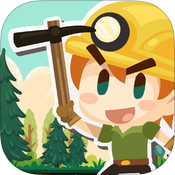
Before I get too deep into my issues with the game, let’s jump over to one of Roofdog Game’s other games, Pocket Mine.
I have issues with Pocket Mine because of how rogue-like it is, but again, I’m here to talk about the digital currency.
The game is “simple.” You dig and get ores. Each ore has a different ore-to-dollar conversion rate, with rare ores being worth more, and some can be modified by power-up cards you use on each dig. You can find different artifacts while you dig and those will give you various amounts of cash as well.
At the end of each dig you get your money and can use the money to buy better picks and to fuse power-up cards together to make better power-ups. (Getting cards seems to be one of the many different goals of the game.)
In order to get cards, you have to find chests as you dig, but to open the chests you need to use a number of keys, which can be won for doing missions. The other way to get cards is to win them, by collecting a set of artifacts and turning them in for your reward. As I write this there are 135 different artifacts which come in sets of 5. You can get rewards for collecting all items from a set, three of each item in a set, and five of each item in each set.
Oh, and you can buy keys with Rubies too. What are Rubies? Rubies are an in game currency which can only be purchased using real-money. Rubies allow you to buy card packs or keys. In the latest update, Rubies can also be used to release helpers which apparently can be added to your party and help you dig.
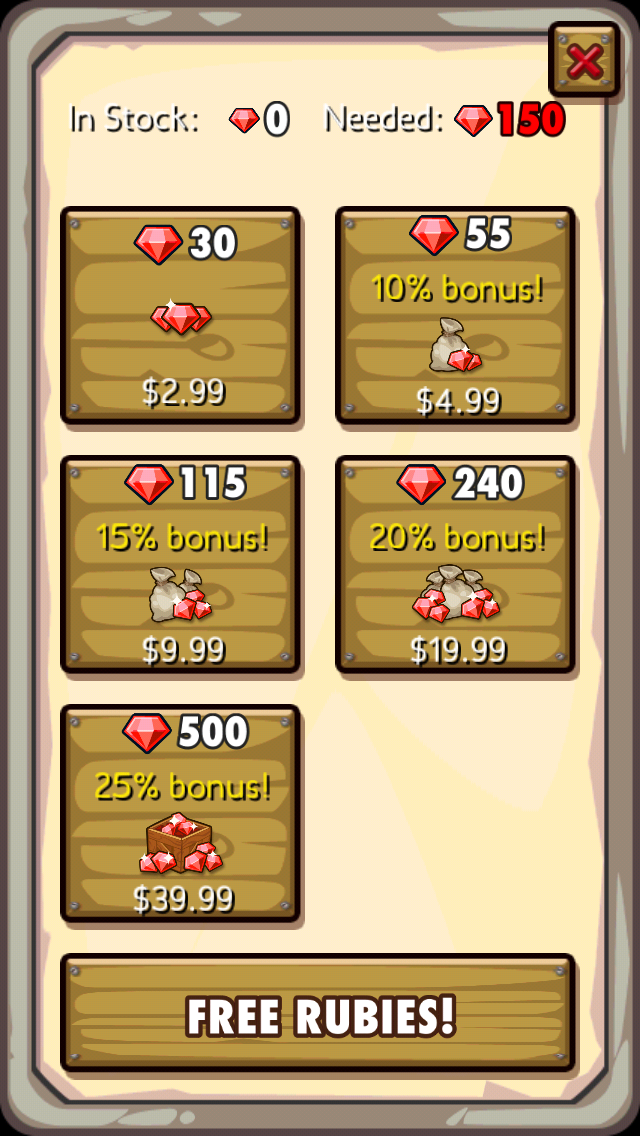
The nostalgia of the game pausing for an “Insert Coin to Continue” moment is lost on me, never having lived in the realm of arcades. While the concept is interesting, the idea of spending $10 in a game on my phone when I don’t even know what it does, is a bit of a deal breaker.

I understand that the game is free, but is it necessary to stand next to me with your hand outstretched, clearing your throat every few minutes? If you’re that hard up for cash, don’t give the game away.
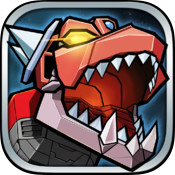
There’s one more game I want to focus on and that’s the latest creation by Halfbrick, Colossatron: Massive World Threat.
Colossatron might be a bit confusing at first, but they did something with multiple currencies and I think they did it right.
The game concept and gameplay are quite different than you might expect. The concept is that you “play” as an alien robot monster that crashes into the Earth and does massive amounts of property damage. Most of this is actually automatic, as the main portion of gameplay involves you connecting different colored pieces together to make Colossatron stronger.
It’s really a “match three” game. Colored segments appear and you pull them into Colossatron. Put three red ones together and they merge into a bigger red segment. Put three of the bigger ones in a row and boom, it gets even stronger.

It’s kinda like Bejeweled meets FlightControl. The trick is adding pieces to Colossatron while he is moving around destroying the city and being shot at by the military. The pieces come in three colors, red, blue, and yellow. But putting different colored pieces next to each other can result in them combining into purple, green, and orange.
The currency is pretty simple, for every dollar of property damage you do, you get a dollar to spend on upgrades. The numbers are usually in the millions and each level requires re-purchasing certain options, which usually isn’t a problem.
The other “currency” is Prisms. You can get prisms from beating the final level of each stage and by finding upgrades in some stages. If you need to buy prisms you can do so in the store for real-money.
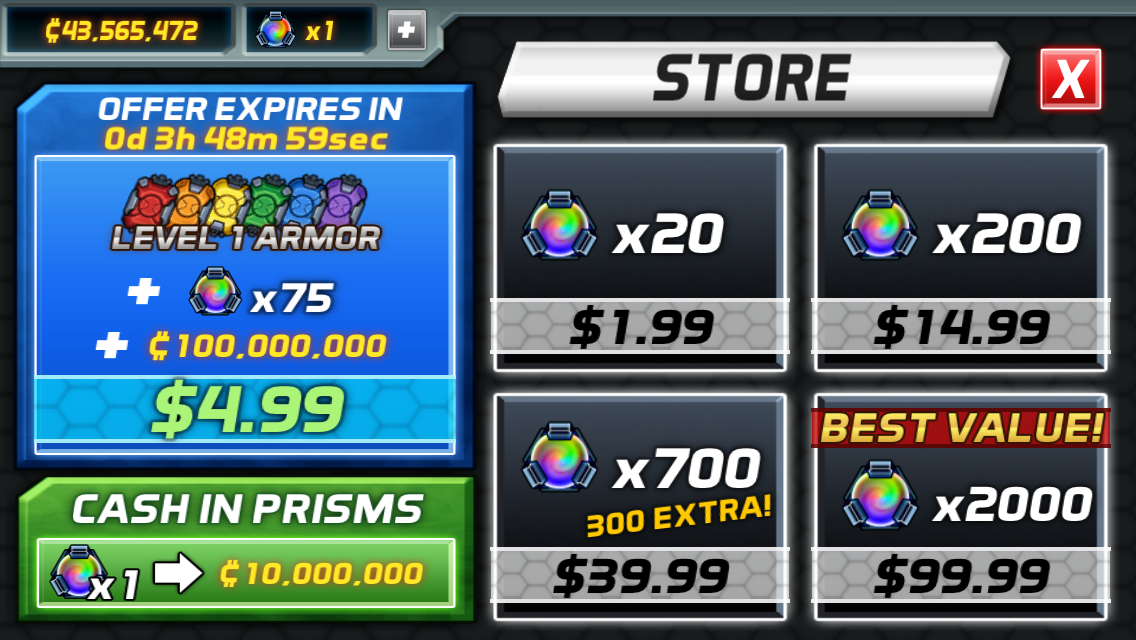
I really like the system they setup for Prisms, and here’s why.
First off, you can find them in-game. If you REALLY don’t want buy them, you don’t need to. You just need to invest a lot more time playing the game.
Secondly, you can convert Prisms into cash. By cashing them in, each prism is worth $10,000,000. While you can’t buy Prisms with in-game cash, they do have a set value within the realm of the game.
Finally, they have a set use-case. Yes, you can use Prisms to get more cash and you can use them to continue your game when you lose, but the main use for Prisms is weapon upgrades. The game allows you to purchase four levels of armor upgrades for each of the different colored pieces. These require an increasing number of Prisms for each level, but the armor upgrades are yours to keep.
Each color has three different weapon options, only one can be equipped at a time. The game will rotate through each of these weapons, changing every 24 hours to a new set. To unlock a weapon permanently, you just have to pay 15 Prisms.
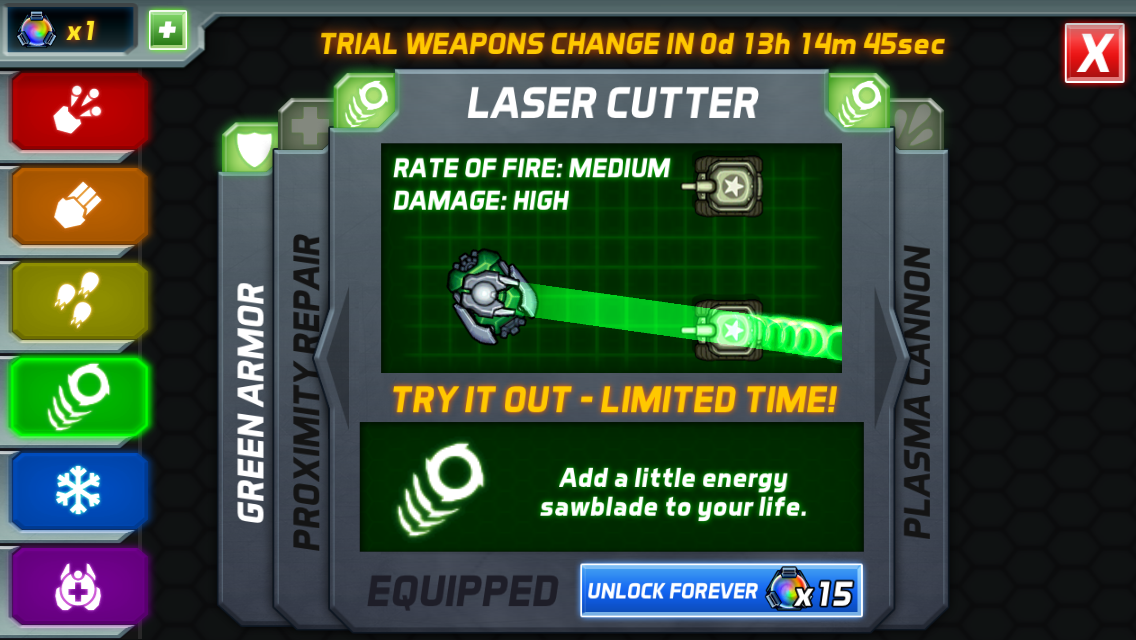
This is great design because it allows you to test out all the weapons before you are required to spend your Prisms on something. Where Pocket Mine asked for money to buy things, sight unseen, Colossatron lets me use everything, provided I am willing to do it on their terms. If I find a weapon that I really like or is really useful, such as Repair Drones, I am invited to unlock it forever.
So what do we learn here?
There’s a few things I think we can take away from this.
Make currency part of the game. It may not be obvious at first, but the coins in Jetpack Joyride are not just there to let you buy different clothes and the occasional upgrade. Sure, the cosmetic changes are fun and the gadgets and utilities keep it interesting, but at a lower level the coins are a distraction. If your goal is distance, the coins are only going to get you killed. If you’re going for a mission, the coins have potential to pull you away. Subconsciously, they make you make choices about what is more important.
In Extreme Roadtrip 2, the coins are only there to buy cars. Occasionally they may be a trap you need to avoid, but they don’t have the same meaning they do in Jetpack Joyride. In Colossatron the cash is a necessity to progress, but getting it is almost an afterthought. It’s not what you’re trying to do. With Prisms, you’re rewarded when you beat the stage and then use them to make strategic choices about what will work best. In Dots, you can’t not get dots, and while the power-ups aren’t essential to the gameplay, the system is natural.
Pocket Mine… well, that’s just a mess.
Make the currency available in-game. Even if it’s rare, you should be able to get the currency without having to buy it. Pocket Mine is as close as you can get to a Pay-to-Play game without requiring you to pay to play. I’m level 39 and I haven’t spent a penny on it.
Keep it simple. Dots and Jetpack Joyride do an amazing job of keeping the currency simple. It’s natural and it works. Pocket Mine and Extreme Roadtrip 2 have convoluted systems for achieving various currencies and specific rules about how each one works. For a simple “endless running” game, it shouldn’t be that difficult.
Tact is important. I can only speak for myself but I would rather pay a few dollars up-front than be continually pestered about spending money. If you want to support your game with ads, that’s fine, but if you expect me to spend money, be clear about it and don’t be obnoxious.
If you give a game away for free, invite me to pay, give me incentives to pay, don’t require it. Maybe this is a little nit-picky, maybe you could argue that I’m reading too much into it, but as I watch fun games continue to be updated with ads, more paywalls, and features that cost money I lose interest because it’s clear the developer is more interested in taking my cash than giving me a good experience.
Don’t get me wrong, I don’t expect these devs to work for free. I’m not trying to say money isn’t important. The way you approach your audience is important, though.
1. I hesitate to admit to the 1D, 7H, 38M, 46S that the game recorded me playing, though to be fair, SOME of that is my younger cousins. Honest. ↩
2. Despite my complaints, I do have 57H, 40M, and 51S logged at the time of this writing. ↩